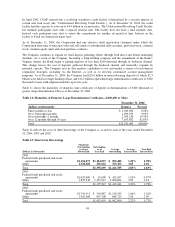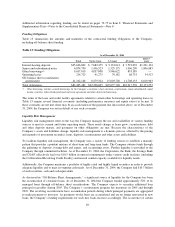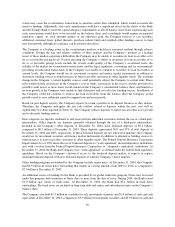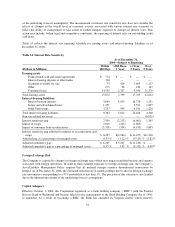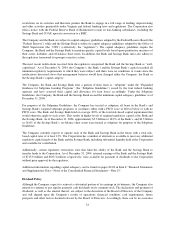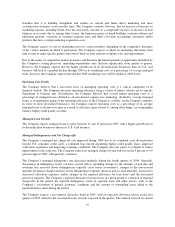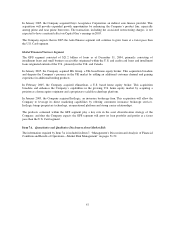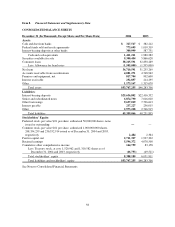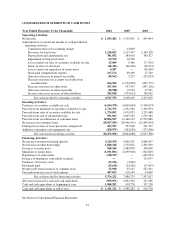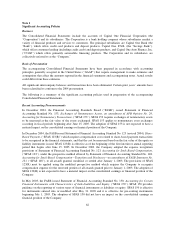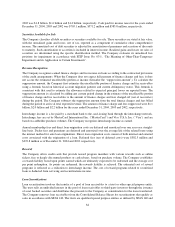Capital One 2004 Annual Report Download - page 77
Download and view the complete annual report
Please find page 77 of the 2004 Capital One annual report below. You can navigate through the pages in the report by either clicking on the pages listed below, or by using the keyword search tool below to find specific information within the annual report.that the Corporation will declare and pay any dividends. As a holding company, the ability of the Corporation to
pay dividends is dependent upon the receipt of dividends or other payments from its subsidiaries. Applicable
banking regulations and provisions that may be contained in borrowing agreements of the Corporation or its
subsidiaries may restrict the ability of the Corporation’s subsidiaries to pay dividends to the Corporation or the
ability of the Corporation to pay dividends to its stockholders.
Business Outlook
This business outlook section summarizes the Company’s expectations for earnings for 2005, and its primary
goals and strategies for continued growth. The statements contained in this section are based on management’s
current expectations and do not take into account any acquisitions, including the pending acquisition of Hibernia,
that might occur during the year. Certain statements are forward looking, and therefore actual results could differ
materially from those in our forward looking statements. Factors that could materially influence results are set
forth throughout this section and on page 18 in Item 1 “Business – Risk Factors.”
Earnings Goals
The Company expects diluted earnings per share results between $6.60 and $7.00 in 2005, which represents an
increase of between 6% and 13% over its diluted earnings per share of $6.21 in 2004. The expected diluted
earnings per share results for 2005 include the impact of the issuance of common stock under the forward
purchase contracts in May of 2005 related to the upper DECs issued in April of 2002.
The Company’s 2005 earnings per share estimate is based on its expectations for continued strong earnings in its
U.S. Card segment and increasing earnings contributions from its Auto Finance and Global Financial Services
segments. The Company anticipates its managed loan growth rate in 2005 to be between 12 and 15 percent, with
a higher growth rate in its diversification businesses than in its U.S. Card business.
The Company’s earnings are a function of its revenues (net interest income and non-interest income), consumer
usage, payment and attrition patterns, the credit quality and growth rate of its earning assets (which affect fees,
charge-offs and provision expense) and the Company’s marketing and operating expenses. Specific factors likely
to affect the Company’s 2005 earnings are the portion of its loan portfolio it holds in lower loss assets, changes
in consumer payment behavior, the competitive, legal, regulatory and reputational environment and the level of
investments and growth in its diversification businesses.
The Company expects to achieve these results based on the continued success of its business strategies and its
current assessment of the competitive, regulatory and funding market environments that it faces (each of which is
discussed elsewhere in this document), as well as the expectation that the geographies in which the Company
competes will not experience significant consumer credit quality erosion, as might be the case in an economic
downturn or recession.
Managed Revenue Margin
The Company expects its managed revenue margin (defined as managed net interest income plus managed non-
interest income divided by average managed earning assets) to be modestly lower over time as a result of the
Company’s continuing diversification efforts and its bias towards lower loss assets. Due to their product features,
these assets may generate lower fee and interest revenue as a percentage of average loan balance than the
Company’s current portfolio. However, as discussed more fully below, assets held in the Company’s
diversification businesses typically have higher average balances than the loans in the Company’s current
portfolio and, as a result, the Company is expected to have lower operating and marketing expenses as a
percentage of average managed loans. The Company also expects these assets to have lower charge-offs.
Marketing Investment
The Company expects its’ marketing investment, including brand, in 2005 to be similar to that experienced in
2004, subject to opportunities it perceives in the competitive market. The Company believes the branded
54






